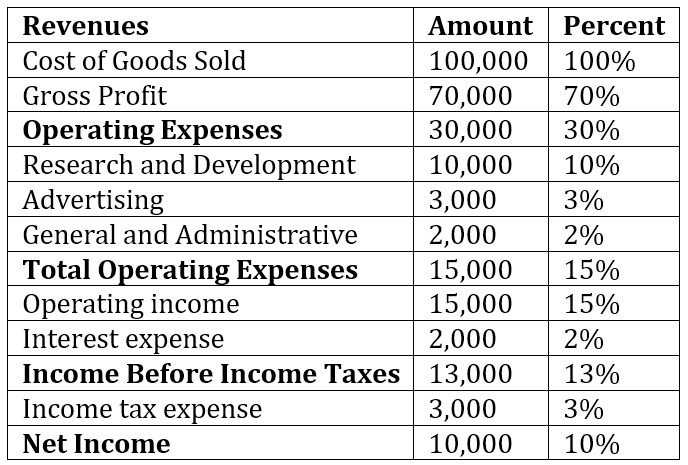For example heres the 3 months ended 2018 and 2017 income statement of ShotSpotter. In the example shown the formula in K7 is. The common size version of this income statement divides each line item by revenue or 100000. We calculate Combined Common-Size and Base Year Assets by this formula. For example if the item of interest is inventory and it is referenced to total assets as it normally would be the common size ratio would be. A common size income statement is an income statement in which each line item is expressed as a percentage of the value of sales to make analysis easier. To find the common size ratio of each sales line item take the amount and divide it by 350000. Amount Base amount and multiply by 100 to get a percentage. The calculation for common-size percentages is. Revenue divided by 100000 is 100.
The calculation for common-size percentages is. To calculate current stock or inventory you can use Excel Tables with a formula based on the SUMIF function. Revenue for the 3 months ended June 30 2018 is calculated as 89278927 100. A common size income statement is an income statement in which each line item is expressed as a percentage of the value of sales to make analysis easier. The common size version of this income statement divides each line item by revenue or 100000. For example gross margin is calculated by dividing gross profit by sales. Take your beginning inventory for a given period of time usually a month. Add that number to your end of period inventory month season or year and then divide by 2 or 7 13 etc. Gross profit operating income marketing expenses by revenue or sales. The common size ratio for each line on the financial statement is calculated as follows.
We calculate Combined Common-Size and Base Year Assets by this formula. For example gross margin is calculated by dividing gross profit by sales. Common size simply is when you take each line on the income statement and divide it by the revenue in the same period. Revenue divided by 100000 is 100. Although these are a little different the formula above is the starting point for both. This format is useful for comparing the proportions of assets liabilities and equity between different companies particularly as part of an industry analysis or an acquisition analysis. Each item is then expressed as a percentage of sales. The common size version of this income statement divides each line item by revenue or 100000. Revenue for the 3 months ended June 30 2018 is calculated as 89278927 100. In the short term a companys executives can compare.
This format is useful for comparing the proportions of assets liabilities and equity between different companies particularly as part of an industry analysis or an acquisition analysis. Common-size amount common year Common- size amount base year. Revenue for the 3 months ended June 30 2018 is calculated as 89278927 100. The calculation for common-size percentages is. For example heres the 3 months ended 2018 and 2017 income statement of ShotSpotter. Common size analysis can be conducted in two ways ie vertical analysis and horizontal analysis. Common size simply is when you take each line on the income statement and divide it by the revenue in the same period. In the example shown the formula in K7 is. Add that number to your end of period inventory month season or year and then divide by 2 or 7 13 etc. A common size balance sheet displays the numeric and relative values of all presented asset liability and equity line items.
For example if the item of interest is inventory and it is referenced to total assets as it normally would be the common size ratio would be. Add that number to your end of period inventory month season or year and then divide by 2 or 7 13 etc. This means your common size ratios are. A common size balance sheet displays the numeric and relative values of all presented asset liability and equity line items. Now lets look at a few items in common size. This format is useful for comparing the proportions of assets liabilities and equity between different companies particularly as part of an industry analysis or an acquisition analysis. Common size simply is when you take each line on the income statement and divide it by the revenue in the same period. Common-size amount common year Common- size amount base year. Revenue for the 3 months ended June 30 2018 is calculated as 89278927 100. We calculate Combined Common-Size and Base Year Assets by this formula.
